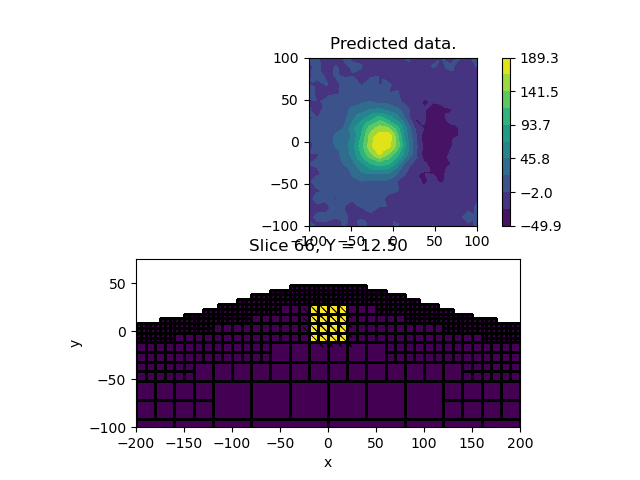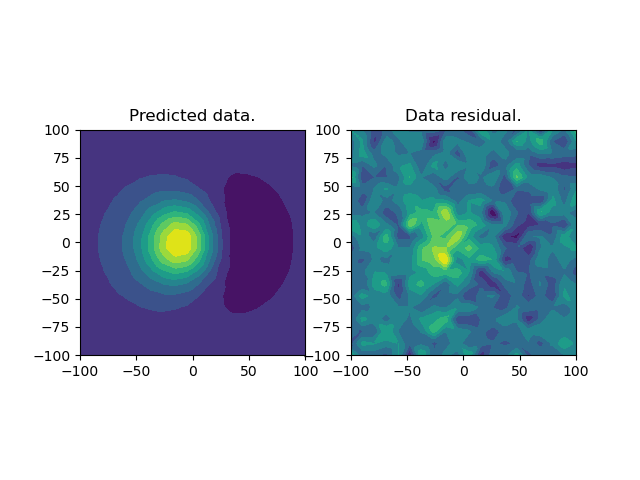Note
Go to the end to download the full example code.
Magnetic inversion on a TreeMesh#
In this example, we demonstrate the use of a Magnetic Vector Inverison on 3D TreeMesh for the inversion of magnetics affected by remanence. The mesh is auto-generated based on the position of the observation locations and topography.
We invert the data twice, first for a smooth starting model using the Cartesian coordinate system, and second for a compact model using the Spherical formulation.
The inverse problem uses the :class:’simpeg.regularization.Sparse’ that
from simpeg import (
data,
data_misfit,
directives,
maps,
inverse_problem,
optimization,
inversion,
regularization,
)
from simpeg import utils
from simpeg.utils import mkvc
from discretize.utils import active_from_xyz, mesh_builder_xyz, refine_tree_xyz
from simpeg.potential_fields import magnetics
import scipy as sp
import numpy as np
import matplotlib.pyplot as plt
# sphinx_gallery_thumbnail_number = 3
Setup#
Define the survey and model parameters
First we need to define the direction of the inducing field As a simple case, we pick a vertical inducing field of magnitude 50,000 nT.
np.random.seed(1)
# We will assume a vertical inducing field
h0_amplitude, h0_inclination, h0_declination = (50000.0, 90.0, 0.0)
# The magnetization is set along a different direction (induced + remanence)
M = np.array([45.0, 90.0])
# Create grid of points for topography
# Lets create a simple Gaussian topo and set the active cells
[xx, yy] = np.meshgrid(np.linspace(-200, 200, 50), np.linspace(-200, 200, 50))
b = 100
A = 50
zz = A * np.exp(-0.5 * ((xx / b) ** 2.0 + (yy / b) ** 2.0))
topo = np.c_[utils.mkvc(xx), utils.mkvc(yy), utils.mkvc(zz)]
# Create an array of observation points
xr = np.linspace(-100.0, 100.0, 20)
yr = np.linspace(-100.0, 100.0, 20)
X, Y = np.meshgrid(xr, yr)
Z = A * np.exp(-0.5 * ((X / b) ** 2.0 + (Y / b) ** 2.0)) + 5
# Create a MAGsurvey
xyzLoc = np.c_[mkvc(X.T), mkvc(Y.T), mkvc(Z.T)]
rxLoc = magnetics.receivers.Point(xyzLoc)
srcField = magnetics.sources.UniformBackgroundField(
receiver_list=[rxLoc],
amplitude=h0_amplitude,
inclination=h0_inclination,
declination=h0_declination,
)
survey = magnetics.survey.Survey(srcField)
# Here how the topography looks with a quick interpolation, just a Gaussian...
tri = sp.spatial.Delaunay(topo)
fig = plt.figure()
ax = fig.add_subplot(1, 1, 1, projection="3d")
ax.plot_trisurf(
topo[:, 0], topo[:, 1], topo[:, 2], triangles=tri.simplices, cmap=plt.cm.Spectral
)
ax.scatter3D(xyzLoc[:, 0], xyzLoc[:, 1], xyzLoc[:, 2], c="k")
plt.show()

Inversion Mesh#
Here, we create a TreeMesh with base cell size of 5 m. We created a small utility function to center the mesh around points and to figure out the outermost dimension for adequate padding distance. The second stage allows us to refine the mesh around points or surfaces (point assumed to follow some horizontal trend) The refinement process is repeated twice to allow for a finer level around the survey locations.
# Create a mesh
h = [5, 5, 5]
padDist = np.ones((3, 2)) * 100
mesh = mesh_builder_xyz(
xyzLoc, h, padding_distance=padDist, depth_core=100, mesh_type="tree"
)
mesh = refine_tree_xyz(
mesh, topo, method="surface", octree_levels=[4, 4], finalize=True
)
# Define an active cells from topo
actv = active_from_xyz(mesh, topo)
nC = int(actv.sum())
/home/vsts/work/1/s/examples/03-magnetics/plot_inv_mag_MVI_Sparse_TreeMesh.py:115: DeprecationWarning:
The surface option is deprecated as of `0.9.0` please update your code to use the `TreeMesh.refine_surface` functionality. It will be removed in a future version of discretize.
Forward modeling data#
We can now create a magnetization model and generate data Lets start with a block below topography
model = np.zeros((mesh.nC, 3))
# Convert the inclination declination to vector in Cartesian
M_xyz = utils.mat_utils.dip_azimuth2cartesian(M[0], M[1])
# Get the indicies of the magnetized block
ind = utils.model_builder.get_indices_block(
np.r_[-20, -20, -10],
np.r_[20, 20, 25],
mesh.gridCC,
)[0]
# Assign magnetization values
model[ind, :] = np.kron(np.ones((ind.shape[0], 1)), M_xyz * 0.05)
# Remove air cells
model = model[actv, :]
# Create active map to go from reduce set to full
actvMap = maps.InjectActiveCells(mesh, actv, np.nan)
# Creat reduced identity map
idenMap = maps.IdentityMap(nP=nC * 3)
# Create the simulation
simulation = magnetics.simulation.Simulation3DIntegral(
survey=survey, mesh=mesh, chiMap=idenMap, ind_active=actv, model_type="vector"
)
# Compute some data and add some random noise
d = simulation.dpred(mkvc(model))
std = 5 # nT
synthetic_data = d + np.random.randn(len(d)) * std
wd = np.ones(len(d)) * std
# Assign data and uncertainties to the survey
data_object = data.Data(survey, dobs=synthetic_data, standard_deviation=wd)
# Create an projection matrix for plotting later
actv_plot = maps.InjectActiveCells(mesh, actv, np.nan)
# Plot the model and data
plt.figure()
ax = plt.subplot(2, 1, 1)
im = utils.plot_utils.plot2Ddata(xyzLoc, synthetic_data, ax=ax)
plt.colorbar(im[0])
ax.set_title("Predicted data.")
plt.gca().set_aspect("equal", adjustable="box")
# Plot the vector model
ax = plt.subplot(2, 1, 2)
mesh.plot_slice(
actv_plot * model.reshape((-1, 3), order="F"),
v_type="CCv",
view="vec",
ax=ax,
normal="Y",
ind=66,
grid=True,
quiver_opts={
"pivot": "mid",
"scale": 5 * np.abs(model).max(),
"scale_units": "inches",
},
)
ax.set_xlim([-200, 200])
ax.set_ylim([-100, 75])
ax.set_xlabel("x")
ax.set_ylabel("y")
plt.gca().set_aspect("equal", adjustable="box")
plt.show()

Inversion#
We can now attempt the inverse calculations. We put great care into designing an inversion methology that would yield a geologically reasonable solution for the non-induced problem. The inversion is done in two stages. First we compute a smooth solution using a Cartesian coordinate system, then a sparse inversion in the Spherical domain.
# Create sensitivity weights from our linear forward operator
rxLoc = survey.source_field.receiver_list[0].locations
# This Mapping connects the regularizations for the three-component
# vector model
wires = maps.Wires(("p", nC), ("s", nC), ("t", nC))
m0 = np.ones(3 * nC) * 1e-4 # Starting model
# Create three regularizations for the different components
# of magnetization
reg_p = regularization.Sparse(mesh, active_cells=actv, mapping=wires.p)
reg_p.reference_model = np.zeros(3 * nC)
reg_s = regularization.Sparse(mesh, active_cells=actv, mapping=wires.s)
reg_s.reference_model = np.zeros(3 * nC)
reg_t = regularization.Sparse(mesh, active_cells=actv, mapping=wires.t)
reg_t.reference_model = np.zeros(3 * nC)
reg = reg_p + reg_s + reg_t
reg.reference_model = np.zeros(3 * nC)
# Data misfit function
dmis = data_misfit.L2DataMisfit(simulation=simulation, data=data_object)
dmis.W = 1.0 / data_object.standard_deviation
# Add directives to the inversion
opt = optimization.ProjectedGNCG(
maxIter=10, lower=-10, upper=10.0, maxIterLS=20, maxIterCG=20, tolCG=1e-4
)
invProb = inverse_problem.BaseInvProblem(dmis, reg, opt)
# A list of directive to control the inverson
betaest = directives.BetaEstimate_ByEig(beta0_ratio=1e1)
# Add sensitivity weights
sensitivity_weights = directives.UpdateSensitivityWeights()
# Here is where the norms are applied
# Use a threshold parameter empirically based on the distribution of
# model parameters
IRLS = directives.Update_IRLS(f_min_change=1e-3, max_irls_iterations=2, beta_tol=5e-1)
# Pre-conditioner
update_Jacobi = directives.UpdatePreconditioner()
inv = inversion.BaseInversion(
invProb, directiveList=[sensitivity_weights, IRLS, update_Jacobi, betaest]
)
# Run the inversion
mrec_MVIC = inv.run(m0)
Running inversion with SimPEG v0.22.1
simpeg.InvProblem is setting bfgsH0 to the inverse of the eval2Deriv.
***Done using the default solver Pardiso and no solver_opts.***
model has any nan: 0
=============================== Projected GNCG ===============================
# beta phi_d phi_m f |proj(x-g)-x| LS Comment
-----------------------------------------------------------------------------
x0 has any nan: 0
0 1.03e+06 2.48e+04 2.40e-03 2.73e+04 3.01e+03 0
1 5.13e+05 1.60e+04 4.55e-03 1.83e+04 2.80e+03 0
2 2.57e+05 1.09e+04 9.92e-03 1.35e+04 2.35e+03 0 Skip BFGS
3 1.28e+05 6.59e+03 2.20e-02 9.41e+03 2.22e+03 0 Skip BFGS
4 6.41e+04 3.30e+03 4.01e-02 5.87e+03 2.07e+03 0 Skip BFGS
5 3.21e+04 1.40e+03 6.06e-02 3.34e+03 1.91e+03 0 Skip BFGS
6 1.60e+04 5.38e+02 7.90e-02 1.81e+03 1.74e+03 0 Skip BFGS
Reached starting chifact with l2-norm regularization: Start IRLS steps...
irls_threshold 0.005134596623176364
irls_threshold 0.003465728800878635
irls_threshold 0.006175542133467039
7 8.02e+03 2.00e+02 1.23e-01 1.19e+03 1.37e+03 0 Skip BFGS
8 2.34e+04 1.04e+02 1.59e-01 3.83e+03 1.96e+03 0 Skip BFGS
Reach maximum number of IRLS cycles: 2
------------------------- STOP! -------------------------
1 : |fc-fOld| = 0.0000e+00 <= tolF*(1+|f0|) = 2.7309e+03
1 : |xc-x_last| = 1.7720e-02 <= tolX*(1+|x0|) = 1.0336e-01
0 : |proj(x-g)-x| = 1.9561e+03 <= tolG = 1.0000e-01
0 : |proj(x-g)-x| = 1.9561e+03 <= 1e3*eps = 1.0000e-02
0 : maxIter = 10 <= iter = 9
------------------------- DONE! -------------------------
Sparse Vector Inversion#
Re-run the MVI in the spherical domain so we can impose sparsity in the vectors.
spherical_map = maps.SphericalSystem()
m_start = utils.mat_utils.cartesian2spherical(mrec_MVIC.reshape((nC, 3), order="F"))
beta = invProb.beta
dmis.simulation.chiMap = spherical_map
dmis.simulation.model = m_start
# Create a block diagonal regularization
wires = maps.Wires(("amp", nC), ("theta", nC), ("phi", nC))
# Create a Combo Regularization
# Regularize the amplitude of the vectors
reg_a = regularization.Sparse(
mesh,
gradient_type="total",
active_cells=actv,
mapping=wires.amp,
norms=[0.0, 1.0, 1.0, 1.0], # Only norm on gradients used,
reference_model=np.zeros(3 * nC),
)
# Regularize the vertical angle of the vectors
reg_t = regularization.Sparse(
mesh,
gradient_type="total",
active_cells=actv,
mapping=wires.theta,
alpha_s=0.0, # No reference angle,
norms=[0.0, 1.0, 1.0, 1.0], # Only norm on gradients used,
)
reg_t.units = "radian"
# Regularize the horizontal angle of the vectors
reg_p = regularization.Sparse(
mesh,
gradient_type="total",
active_cells=actv,
mapping=wires.phi,
alpha_s=0.0, # No reference angle,
norms=[0.0, 1.0, 1.0, 1.0], # Only norm on gradients used,
)
reg_p.units = "radian"
reg = reg_a + reg_t + reg_p
reg.reference_model = np.zeros(3 * nC)
lower_bound = np.kron(np.asarray([0, -np.inf, -np.inf]), np.ones(nC))
upper_bound = np.kron(np.asarray([10, np.inf, np.inf]), np.ones(nC))
# Add directives to the inversion
opt = optimization.ProjectedGNCG(
maxIter=20,
lower=lower_bound,
upper=upper_bound,
maxIterLS=20,
maxIterCG=30,
tolCG=1e-3,
stepOffBoundsFact=1e-3,
)
opt.approxHinv = None
invProb = inverse_problem.BaseInvProblem(dmis, reg, opt, beta=beta)
# Here is where the norms are applied
irls = directives.Update_IRLS(
f_min_change=1e-4,
max_irls_iterations=20,
minGNiter=1,
beta_tol=0.5,
coolingRate=1,
coolEps_q=True,
sphericalDomain=True,
)
# Special directive specific to the mag amplitude problem. The sensitivity
# weights are updated between each iteration.
spherical_projection = directives.ProjectSphericalBounds()
sensitivity_weights = directives.UpdateSensitivityWeights()
update_Jacobi = directives.UpdatePreconditioner()
inv = inversion.BaseInversion(
invProb,
directiveList=[spherical_projection, irls, sensitivity_weights, update_Jacobi],
)
mrec_MVI_S = inv.run(m_start)
Running inversion with SimPEG v0.22.1
simpeg.InvProblem will set Regularization.reference_model to m0.
simpeg.InvProblem will set Regularization.reference_model to m0.
simpeg.InvProblem is setting bfgsH0 to the inverse of the eval2Deriv.
***Done using the default solver Pardiso and no solver_opts.***
model has any nan: 0
=============================== Projected GNCG ===============================
# beta phi_d phi_m f |proj(x-g)-x| LS Comment
-----------------------------------------------------------------------------
x0 has any nan: 0
0 1.61e+04 6.41e+02 1.29e-01 2.71e+03 1.21e+03 0
1 8.03e+03 7.47e+02 1.15e-01 1.67e+03 1.11e+03 1
2 4.01e+03 7.35e+02 1.14e-01 1.19e+03 1.13e+03 5
3 2.01e+03 6.94e+02 1.14e-01 9.24e+02 1.09e+03 3 Skip BFGS
4 1.00e+03 4.65e+02 1.35e-01 6.00e+02 9.49e+02 1
5 5.02e+02 4.37e+02 1.33e-01 5.04e+02 9.31e+02 2
Reached starting chifact with l2-norm regularization: Start IRLS steps...
irls_threshold 0.006981856186026226
irls_threshold 2.211878441944454
irls_threshold 6.28119126838534
6 2.51e+02 3.27e+01 3.00e-01 1.08e+02 7.95e+02 0
7 1.90e+03 3.04e+01 3.38e-01 6.73e+02 5.87e+02 3
8 8.06e+03 6.16e+01 3.93e-01 3.23e+03 4.81e+02 2
9 8.06e+03 5.65e+02 4.24e-01 3.99e+03 5.82e+02 1
10 5.51e+03 6.49e+02 4.23e-01 2.98e+03 6.53e+02 3
11 3.67e+03 6.87e+02 5.24e-01 2.61e+03 7.28e+02 1
12 2.41e+03 7.07e+02 5.30e-01 1.99e+03 8.06e+02 3
13 2.41e+03 3.09e+02 7.14e-01 2.03e+03 8.80e+02 0 Skip BFGS
14 2.41e+03 4.48e+02 7.37e-01 2.23e+03 8.66e+02 1
15 2.41e+03 5.88e+02 7.78e-01 2.46e+03 1.02e+03 1
16 1.68e+03 6.25e+02 7.48e-01 1.88e+03 1.09e+03 2
17 1.68e+03 4.49e+02 8.68e-01 1.90e+03 7.67e+02 0
18 1.68e+03 5.68e+02 7.91e-01 1.89e+03 8.97e+02 2
19 1.68e+03 5.00e+02 8.10e-01 1.86e+03 9.00e+02 0
20 1.68e+03 5.20e+02 7.78e-01 1.82e+03 8.81e+02 3
------------------------- STOP! -------------------------
1 : |fc-fOld| = 3.4775e+01 <= tolF*(1+|f0|) = 2.7134e+02
1 : |xc-x_last| = 3.5324e+01 <= tolX*(1+|x0|) = 3.7011e+01
0 : |proj(x-g)-x| = 8.8102e+02 <= tolG = 1.0000e-01
0 : |proj(x-g)-x| = 8.8102e+02 <= 1e3*eps = 1.0000e-02
1 : maxIter = 20 <= iter = 20
------------------------- DONE! -------------------------
Final Plot#
Let’s compare the smooth and compact model
plt.figure(figsize=(8, 8))
ax = plt.subplot(2, 1, 1)
mesh.plot_slice(
actv_plot * mrec_MVIC.reshape((nC, 3), order="F"),
v_type="CCv",
view="vec",
ax=ax,
normal="Y",
ind=66,
grid=True,
quiver_opts={
"pivot": "mid",
"scale": 5 * np.abs(mrec_MVIC).max(),
"scale_units": "inches",
},
)
ax.set_xlim([-200, 200])
ax.set_ylim([-100, 75])
ax.set_title("Smooth model (Cartesian)")
ax.set_xlabel("x")
ax.set_ylabel("y")
plt.gca().set_aspect("equal", adjustable="box")
ax = plt.subplot(2, 1, 2)
vec_xyz = utils.mat_utils.spherical2cartesian(
mrec_MVI_S.reshape((nC, 3), order="F")
).reshape((nC, 3), order="F")
mesh.plot_slice(
actv_plot * vec_xyz,
v_type="CCv",
view="vec",
ax=ax,
normal="Y",
ind=66,
grid=True,
quiver_opts={
"pivot": "mid",
"scale": 5 * np.abs(vec_xyz).max(),
"scale_units": "inches",
},
)
ax.set_xlim([-200, 200])
ax.set_ylim([-100, 75])
ax.set_title("Sparse model (L0L2)")
ax.set_xlabel("x")
ax.set_ylabel("y")
plt.gca().set_aspect("equal", adjustable="box")
plt.show()
# Plot the final predicted data and the residual
plt.figure()
ax = plt.subplot(1, 2, 1)
utils.plot_utils.plot2Ddata(xyzLoc, invProb.dpred, ax=ax)
ax.set_title("Predicted data.")
plt.gca().set_aspect("equal", adjustable="box")
ax = plt.subplot(1, 2, 2)
utils.plot_utils.plot2Ddata(xyzLoc, synthetic_data - invProb.dpred, ax=ax)
ax.set_title("Data residual.")
plt.gca().set_aspect("equal", adjustable="box")
Total running time of the script: (1 minutes 15.122 seconds)
Estimated memory usage: 659 MB

